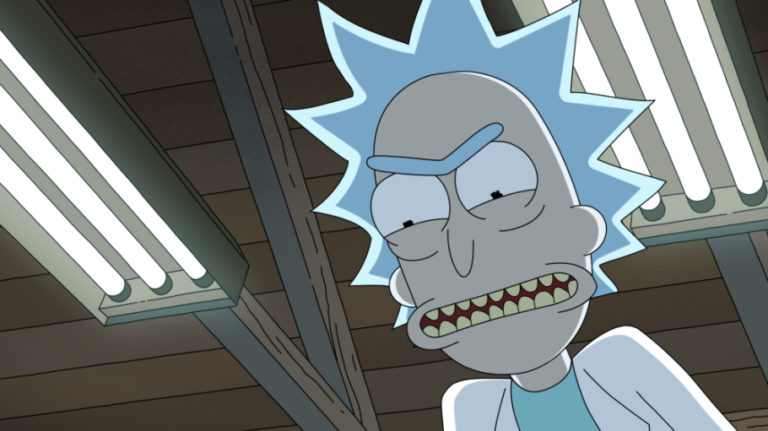SPOILER ALERT: This piece contains spoilers from “Unmortricken,” the fifth episode of “Rick and Morty” Season 7.
Dan Harmon is, by his own admission, “allergic to serialized, canonical stuff.” But the “Rick and Morty” co-creator told Variety that he resisted that impulse for “Unmortricken,” the episode that brought Season 7 of the Adult Swim animated sitcom to its halfway point on Sunday night. Not only does “Unmortricken” check in on the series’ overarching story for the first time since the Season 6 premiere (which aired over a year ago); it also sees the grisly death of a character once built up as the show’s arch-antagonist, even as it gives another an unprecedented level of power within the “Rick and Morty” universe.
Co-written by Albro Lundy and James Siciliano and directed by Jacob Hair, “Unmortricken” opens with what appears to be a standard “Rick and Morty” adventure — until Morty goes on a rampage, dons an eyepatch and becomes the figure fans know as Evil Morty, a super-intelligent version of the 14-year-old protagonist who reverses the typical dynamic of Rick domineering his more docile sidekick. After previously ruling the Citadel, an interdimensional hub of Ricks and Mortys from across the multiverse, Evil Morty is now settled in his personal fortress of solitude, an entire arc compressed into a four-minute cold open.
Meanwhile, Rick C-137 — the main Rick of “Rick and Morty” — is on a mission to track down Rick Prime, the Rick who originally invented portal travel and killed C-137’s wife Diane and daughter Beth. (“Rick and Morty” has since revealed that the Beth we know, along with the entire Smith family, are actually related to Rick Prime, who abandoned them before C-137 took his place.) A bored, jaded Evil Morty tags along as they discover Rick Prime has rebuilt the Omega Device, a super-weapon that terminates all versions of its victims, like Diane. After a brutal, bloody confrontation, Rick C-137 kills Rick Prime with his bare hands, but at the expense of letting Evil Morty escape with a device that could murder any character in an instant.
Lundy and Siciliano both began on “Rick and Morty” as writers’ assistants before working their way up to executive producer. Harmon credits the duo with countering his impulse to keep stories as standalone as possible, which he says was exacerbated by the show’s highly publicized turmoil — culminating in the termination of co-creator and lead voice actor Justin Roiland earlier this year.
“I think now it can be said that there’s been so much turbulence going on behind the scenes that Season 6 kind of represented me [unplugging] those wires from my heart and my obsessive brain. I had to look at the show as a job,” Harmon said.
But younger writers could push for more of what they already admired about the show, like its master narrative of Rick’s (now literal) self-destructive streak and the emotional attachments that separate him from the nihilist, amoral Rick Prime. “It was fantastic,” Harmon added. “That invigorating energy that they bring to the table as people that are able to remain fans of the thing that we’re working on — I really needed that in my darkest hours.”
Other updates on the saga of Rick Prime, Evil Morty and the multiverse have tended to come at traditional TV inflection points like a finale or a premiere. But the writers liked the idea of placing “Unmortricken” in the middle of Season 7, where it’s more likely to come as a surprise.
“It’s something I love about this show,” said showrunner Scott Marder. “That episode would have been a series finale on a lot of shows, and I liked that it was just an episode in the middle of one of our seasons. We move at a really crazy pace.” The demise of Rick Prime has shades of Logan Roy’s sudden death early in the final season of “Succession” — though by the time that episode aired, “Unmortricken” was already in the pipeline. “When ‘Succession’ did it I was like, ‘Ah, damn! Animation takes so long!’” Marder admitted, laughing.
While Evil Morty and Rick Prime were both existing figures in the “Rick and Morty” mythology, they’d never played a joint starring role before, instantly upping the episode’s stakes. “I thought that was a great idea to lean into,” Harmon said. “It gave me vibes of ‘The Wire’ — learning throughout the first season that there’s different flavors of bad guy, and then you get that satisfaction of watching your favorite drug dealers against the one that had absolutely proven himself to be a meritless sociopath. That idea of team ups where it’s not as simple, as saccharine as, ‘I’ll put on a white hat, you put on a white hat. Let’s go after the guy with black hat.’”
Evil Morty is hardly redeemed at the end of the episode; in fact, he’s newly empowered to vaporize anyone at will. But the audience does get a chance to learn more about his psychology just as he’s poised to take on an even more prominent role in the series’ canon.
Rick Prime, meanwhile, gets a fitting send-off: Death by his own hand, or at least a version of it. For Rick C-137, his family’s killer has always been his white whale — the quintessence of all the things he hates, loves, fears and admires about himself, because Rick is always at the center of his own universe. By letting Evil Morty get away with the Omega device, Rick “basically gave a leash that’s around his neck to someone that isn’t him, because he’s more invested consciously in the destruction of himself,” Harmon said. “I think that’s both tragic and also, writers and drunks like me consider that kind of noble and interesting — the commitment to self destruction.”
For someone as averse as Harmon to serialized plots, sending off Rick Prime may seem like a major step. But “I think there’s still a conclusion to a story here,” he argued, “because the narcissist will tell you that destroying yourself, it doesn’t solve a problem.” How Rick reacts to losing his sense of purpose gives the “Rick and Morty” team plenty to work with through the rest of the season.
“What do you do if you’re Braveheart and you’ve been avenging your dead wife and succeed and don’t die, and then live beyond it? Where’s your story go when that’s all that’s defined you?” Marder said.
It’s enough new terrain to explore that Harmon was no longer worried about closing off any potential Rick Prime material.
“This show, the least of its concerns is wearing out its canonical credit card,” Harmon said. “If the show was going to be destroyed, it would have been destroyed by any of the other Godzilla-sized problems that have happened to it, including pandemics, writers’ strikes, and other things.”
“Unmortricken” ends with Rick shellshocked and covered in (sort of) his own blood, staring into space as Mazzy Star’s “Look on Down from the Bridge” plays into the credits. “This is how far we’ve come with Rick’s journey,” Harmon said. “He is now the one who is existentially isolated. He is the one that doesn’t feel like he fits in the universe around him. Which puts him on the same level as a 14-year-old boy learning there’s multiple universes 10 show-years earlier.”
The shoe is firmly on the other foot: Evil Morty has all the cards while Rick, the self-styled master of the universe, has no idea where he stands.
![]() Post Views: 1,654
Post Views: 1,654

